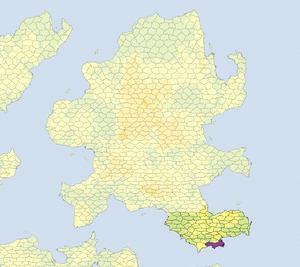| Ruthenia Basileia ton Routhí̱niōn Βασίλειο των Ρουθενια | |
| Motto: Basileus Basileon Basileuon Basileuonton* "King of Kings, Ruling over Rulers" | |
| Anthem: Kli̱ronomiá to̱n Ellí̱no̱n "Legacy of Hellenia" | |
| Geography | |
| - World | White Giant |
| - Continent | Eridana |
| - Region | Bandria Granda |
| - Capital | Auronopolis |
| - Largest city | Auronopolis |
| Official languages | Hellene |
| Ethnic groups | 81% Selloi |
| 6% Mauri | |
| 3% Slavian | |
| 10% Others | |
| Demonym | {{{demonym}}} |
| Government | Imperial Autocracy |
| - Basileus | Alexandros I |
| - Prime Minister | Argirakis Kampouridis |
| Legislature | States General |
| - Upper house | The Senate |
| - Lower house | Chamber of Deputies |
| Events | |
| - Formation | 3216 |
| - Independence declared from the Parsian Empire | 3216 |
| - Ruthenian-Maurian War | 3229 |
| - Joined the CC | 3240 |
| Population | |
| - Total | 24,574,169 |
| Military | |
| - Active personnel | 161,892 |
| Organizations | |
| - Federation | The Union Federation |
| - Common Market | The Union CM |
| - Empire | [[{{{empire}}}]] |
| Production | |
| - Total | SC${{{production_total}}} |
| - Per capita | SC${{{PPC}}} |
| Nominal Value | US$155.98 |
| Currency | Dracma |
| Internet TLD | .rt |
| Drives on the | right |
| URL | Ruthenia in Simcountry. |
| * Ruthenia doesn't have a official state motto, but use the imperial family motto instead, to see other mottos check Unofficial mottos of Ruthenia | |
The Ruthenian Empire or Basileia ton Routhí̱niōn or simply know as Ruthenia its a Country in White Giant planet, in the east of Eridana Continent in the south of Bandria Granda region, considered one of the most eastern countries in the world. Ruthenia its a unitary and multiethnic state compressed in two provinces with a Autocratic Monarchy ruled by a monarch called himself "Basileus". According the 3253 census, Ruthenia total population between the two countries (Ruthenia and Thracia) is around 31 million, Auronopolis is the empire's capital and largest city.
Ruthenia its bordered by Daltona and The Kingdom of Colomo in the north and the Sea of Marmora in the south and east borders, in the west its located the Grand Principate of Thracia under Ruthenian rule and the Principality of Olend beyond the Decannesse Archipielago, under the rule of Daskalaris dynasty, Ruthenia has made many reforms in education, health and military, positioning itself as one of the youngest and prosperous nations of the region.
The nation's history began with that of the Selloi, who emerged as a recognizable group in Eridana between the 2rd and 5th centuries. Founded and ruled by Korimis and Slavian tribes and their descendants, the medieval state of Kormenia arose in the 11th century. In 1000 it adopted Orthodox Christianity since the Council of Beretea, beginning the synthesis of Kormenian and Selloi cultures that defined Ruthene culture for the next millennium. Kormenia ultimately disintegrated into a number of smaller and tributary citizens; most of the Kormenian' lands were overrun by the Parsian invasion and became slaves of the Parsian Empire, By the 31th century they gradually recover their liberties and proclaimed the Enosis in 3176 and dominate the cultural and political legacy of their ancestors' bringing the collapse and the dissolution of Parsian Empire in 3216, Ruthenia reconstituted itself as the Ruthenian Empire and is recognized as the continuing legal personality of the Kormenian and Parsian state.
Ruthenia is afounding member of the interplanetary organization of Council of Centau, the The Union Federation and The Union Common Market
Etimology and Denomyn[]
The identity of the Hellenes has taken many forms in names, with such variants as Hellenoi or Ruthenikoi (meaning "Ruthenes"), Maurikoi (meaning "Mauri") and Latínoi (Meaning "Latins")".
Ruthenia (Routhenia; Ῥωμανία Rutenika) is known to its inhabitants as the "Ruthenian Empire", or the "Empire of the Ruthenes" (Imperium Rutenicum, Imperium Rutenicorum; Βασιλεία τῶν Ῥωμαίων Basileia tōn Rutenion, Ἀρχὴ τῶν ῬωμαίωνArchē tōn Ruthenion.
Within the Ruthenian Empire, a Selloi or Ruthene citizen was generally called a Ruthenian (Ῥωμαῖος), which was first of all defined in opposition to a foreigner, ethnikós (ἐθνικός). The Imperial Selloi were, and perceived themselves as, the descendants of their classical Imperial forebears, the political heirs of Kormenian legacy and descendants of St. Hellena, and followers of the Apostles of Orthodoxy Church.
Thus, their sense of "Hellenization" is different from that of their contemporaries "Ruteic" was the name of the vulgar Hellenic language, as opposed to "Selloi" which was its literary or doctrinal form. "Selloi" (Hellenic: Γραικός) had become synonymous with "Ruthenia" (Hellenic: Ρωμαίος/Ρωμιός) and "Christian" (Hellenic: Χριστιανός) to mean a Christian Hellene citizen of the Ruthenian Empire. There was always an element of indifference or neglect of everything non-Ruthene, which was therefore "foreigner".
Ruthenian as a National Identity[]
Often one's local (geographic) identity could outweigh one's identity as a Ruthenia. The terms xénos (ξένος) and exōtikós ( ἐξωτικός) denoted "people foreign to the local population" ,regardless of whether they were from abroad or from elsewhere within the Ruthene Peninsula.
It is important to understand that the Ruthenian word means more than one ethnic group, but a cultural unification based on customs and understanding under one leadership, this unification to the Hellenes is based on the concept of Enosis, thats why the Hellenes or Ruthenians are those Selloi, Maurian, Slavians, and other ethnic groups united under a common religion, society and history, called themselves as a Ruthenes and heirs of their Korimis ancestors.
The multi-ethnic character of the empire its identifying with cultural elements of different ethnicity both Selloi and Maurian, these being the predominant to identify them as a single term, called Ruthene or Ruthenian, Ruthenia is the land of Ruthenes/Hellenes, or The Empire of Hellenes, both Selloi, Maurian, and other tribes of the region unified in this mutual Heritage and the authority of the Emperor calling himself as Imperator Rutheniae during the Enosis, the Emperor of Ruthenia calling the country and its inhabitans as a Hellenes.
The culture of Ruthenian Empire has evolved over thousands of years of history, Ruthenia have a strong Selloi influence thanks to their Kormenian ancestors, along to Slavinian and Parsian culture and customs, some historians like Nikolaos Choniates declares as "Ruthenia have a multi-ethnic culture with profound bonds between the people united by religion and history, creating a necesity of create our own history" the Ruthene declared himself as "Modern ruthenes", the name of Ruthene applies to the Selloi and Slavian as equal, meanwhile the Mauryan is considered a foreign people but united by common bonds.
Most historians agree that the defining features of their civilization were:
- Selloi (also known as "Hellene") language, culture, literature, and science
- Kormenian law and tradition,
- Christian faith.
The term "Ruthenia" has been adopted by the scholarship on the assumption that anything Selloi is essentially "Ruthene", and also by modern Ruthene scholarship for nationalistic reasons of identification with ancient Kormenia. In modern times, the Ruthene people still use the ethnonyms "Ruthene" and "Hellene" to refer to themselves. In addition, the Kormenian Empire was in language and civilization a Selloi society.
History[]
Origins[]
The first Ruthene people settled in the region when the Selloi and the Mauryans founded several city-states called doukelias in the Rothinoi peninsula, following the Maurian custom of trade and navigation, the city-states prospered and becomes very important in the cultural expansion of the city states. the city-state of Beretea highlighted as the most important city among the ancient Selloi, along with Hispales, where the first signs of orthodox religion born thanks to St. Hellena After thousand years of cultural expansion and conflicts between diversal tribes, St. Hellena of Hispales unify all the tribes and call him after his death did the Selloi call themselves "children of Hellena" and were known by foreigners and Mauryans as "Hellenes" ,
Around the year 1000, Saint Stephanos formed the Kingdom of Kormenia in Beretea and thanks to the trade and religious expansion of the Orthodox Church, the city and has since been in constant conflict with various Rhotinoi city-states in the peninsula, during 500 years Beretea was the center of the Hellene people (the first Korims kings called their people "Hellenes" thanks to the identification of cultural union felt taken by St. Hellena), the Hellenes and the Mauryans lived a long age of prosperity thanks to the Kormenian kings, prosperity that lasted a millennium deeply marking the language, culture and spiritual life of all Selloi.
Thanks to the right and the equal treatment between peoples, the trade conflicts called a expansive an dangerous Parsians in the east of the peninsula, with the city of Ostambal being a rival city of prosperous Kormenian Kingdom, soon the Parsians and the Kormenians competed against each other by the domination of the peninsula. After decades of political and economical tensions, the Parsians declared the war and defeated the Kormenians, destroying his capital in the fall of Beretea.enslaving the Kormenian people every Kormenian citizen, the Hellenes becomes slaves of the Parsians and the few Mauryans called for a plea to the new sultan, creating a autonomous but tributary Mauryian state in the west of the peninsula. meanwhile all the territories of the fallen Korimi kingdom becomes slaves or minor citizens of the now Parsian Empire
The enslavement in this period is known as the "Slavery Era" that will last until 3171 when St. Kallistos manages to negotiate the autonomy of the patriarchate and a group called Eleftherias fights for greater freedoms of the Selloi, creating and promoting the Ruthene spirit and nationalism.
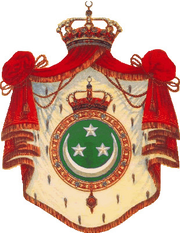
Parsian Empire Coat of Arms
After hundreds of years of subjugation, the Selloi were granted certain rights and were for Maurian governments considered inferior despite their cultural and intellectual contributions beings, Meanwhile, Selloi intellectuals and humanists, who had migrated before or during the Parsian invasions, such as Ambrosios Diaxis and Demetrios Mitropoulos, began to call for the liberation of their homeland. Mitropoulos called on other city states of the region and "all of the Hellenes" to aid the Selloi and Sarbians against "the abominable, monstrous and impious barbarian Parsians". However, Ruthenia was to remain under Parsian rule for at least two more centuries, the only attempt before the interregnum born in 2800, when Count Marcello convinced the Persian sultans to be allowed to form their own independent kingdom as a tributary state of the parsian empire, the kingdom was called Kingdom of Mauria (land of the Maurians) was called and concentrated in the city of Carantia
After the liberation of the Patriarchy caused as a consecuense of the interregnum, little by little small but strong revolts in regions inhabited by Orthodox, isolated but strong attempts of regaining independence, many revolts led by Michael Auronopoulos, many bands and Selloi-Maurians mercenaries around the region unite force against the Parsians as "Ruthenes" for the Ruthenian Liberty, Auronopulos, Michael finally popularized the "Ruthene" name among the Selloi in Parsian lands, Auronopoulos and his army falls in 3175 in the Battle of Koronia and Parsia gains subjugate the revolt, but the legacy of Auronopoulos begins, his sucesors created a intelectual movement called "The Enosis"
The Enosis (3210-3216)[]

Michael Auronopoulos, first Ruthene revolutionary
The Bureaucracy and Religion of all Selloi was Orthodox, the Selloi controlled the church affairs and many domestical affairs like education and scholarship, many of the intellectual was of the countries they conquered,like Maurian, Selloi and Hellenes, the Orthodox Church played a central role in the preservation of national identity as "Hellenes, according to the teachings of St. Helena "the Selloi, the Maurians and the Sarbians are one in the eyes of god, only a basileus can rule the true soul of god" and such instruction was remembered by Gennadios III, ecumenical patriarch of the Orthodox Church in a ecumenical service in Tortossa, since then the development of a Ruthenian society and the resurgence of a Ruthene nationalism in all city states of the peninsula.
The new Ruthenian aristocracy and Selloi prominent families (called as Meteriotes for the Parsians) gained considerable control over Parsian foreign policy and eventually over the bureaucracy as a whole. The Martyrdom was the inspiration of three Selloi/Ruthenian families: the Bagritioni, the Daskalaris and the Philaras, influenced by foreign ideas of imperialism and nationalism, they form part of The Enosis as an important center of mercantile and national affairs against Parsian rule, with the support of wealthy Selloi and ecclesiastical communities, they planned the independence and destruction of Parsian Empire, the formation of is own empire, a own orthodox empire governed by a basileus, chosen by god, a empire of Selloi, Maurian and any ethnicity enslaved by the Parsians, in the 3205 Konstantinos Daskalaris, prominent general in chief of the Parsian Empire is called leader of The Enosis and rapidly expanded and was soon able to recruit members of all Ruthenian world among all members of society.
The Ruthenian enosis soon took advantage of the death of Parsian Sultan to outbreak and planning the insurrection.
The crucial meeting was held in Varasia (actual Euxodion) where chieftains and prelates from all over the peninsula assembled in 3206, the Patriarch Gennadios presented himself as a favoured of the Enosis and the tension of a possible failure begins, sporadic incidents against Parsians occurred, heralding the start of the uprising, the revolution was declared the 29 of June of 3206 by the patriarch himself raised the banner with the cross in the monastery of Agia Lavrea.
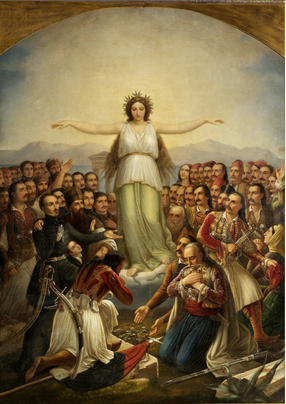
The Liberation of Ruthenia by Stefano Celsi
After 6 years of wars and near 50 years of conflicts for the liberation of the Ruthenes, a vital intervention of Sarbian tributes and the Meteriotes defeated the Parsians in numerous battles along the peninsula, the most recorded battles and decisive in the liberation of the Parsian was Navarena and Ostambal, where the Mauryans allied with the Parsians and the Sarbian navy of Altomanovic defeated the Mauryan navy in the gulf of Navarena, destroying almost all the Parsian fleet and Daskalaris finally reunited all in front of Ostambal, capital of Parsian Empire and fight against the empire for the liberation of the Ruthenes. Daskalaris leaded a offensive in the porte of Ostambal achieved after 3 weeks of siege the opening of the great gate of the city, After twenty years of war and the destruction of almost all the countryside, the Hellenes take Ostambal in April of 3215 by the entrance of Konstantinos Daskalaris and Manuel Notaras in a triunphal entry in the abolished Parsian Empire, after achieved the Parsian Muhammad Hady Faiz, the last governor and loyal to the sultan surrender and ejects completely from the country, with the victory of the revolutionaries and the definitively liberation of all Orthodox people of Ruthenia, victory of the revolutionaries was declared on 23 May 3216 with the victory of the revolutionaries and the definitively liberation of all Ruthenia and the collapse of Parsian Empire.
The consequences of the revolution bring the exile or domination of Parsian people and the birth of Ruthenian Empire, the home of Selloi and all orthodox people, as a whole and new state in the Peninsula. The first Ruthene leader was Konstantinos Daskalaris himself, named Basileus by the Patriarch Gennadios III elected as protector of the Ruthenians, since then Konstantinos is named as Konstantinos I and acclaimed by all the new Ruthene Aristocracy, becomes a Imperial Autocracy with Konstantinos as its founder
Coronation of a Basileus and Reforms (3216-3229)[]
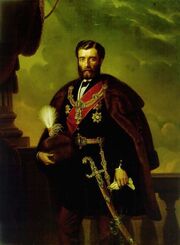
Konstantinos I
The first reforms of the new Basileus was the establishment of the capital of the new empire in Ostambal, renaming the city as Auronopolis in 3216, in memory of Michael Auronopoulos, claim all the penninsula as Ruthene territory and expulsed all the Parsian remnants of the country, and began "Hellenization" of the country, renaming numerous towns, cities and places with Hellenic language, also worked hard at rebuilding the country.
Konstantinos create the charge of Prime Minister after the first encounter with Aquitanian representatives, as an attempt to modernize and imitate the contemporary monarchies but strongly supervised by a hard imperial control, as to the important issues and war the government continued to exert the basileus, also created numerous decrees to protect the Ruthenian identity, the consolidation of the Hellenic language as the official language of Ruthenia, leaving the Maurian as a second language and latin only as an official language for the Ecumenical Patriarchate of Auronopolis and other ecclesiastical and administrative issues.
Set charges and administrative offices external relations in order to avoid unnecessary wars like agains the Maurians and institutionalized the census in the empire, being, from his decree every 10 years, promoted employment and made overtures to neighboring countries for commercial purposes. The effect of these reforms was evident at short time, enhancing freedoms and creating a national consciousness focused on the imperial family and their heritage as Ruthenes.
pushed finances and created a system of aristocracy and bureaucracy only to protect his new imperial power causing great migration and attraction of foreign revolutionaries liberated Selloi and Sarbian people, both ethnic appointed from that day would be Ruthenian and every inhabitant of the country would be now Ruthene, in two years the country is totally Hellenized and habited by ten millions of free Ruthenian people, the new government built numerous schools and founded several universities in order to attract foreign intellectuals, substantially improved employment generating the necessary finances to rebuild the country and expand the empire to the south.once rebuilt the country in 3217, he could say with confidence "Ruthenia is ready to build his own story"
Konstantinos created the council of ministers (symvoúlio), and various reforms with inmediate effect, called as Basilika Decree, the first was the Basilika Decree of Tolerance (liberty of cult in the Empire, besides his role of the Orthodox Church) and other minor reforms to to stabilize and have a "harmonious transit" between the defuncted Parsian Empire and the new Ruthene government.
The Pronoia(3225)[]
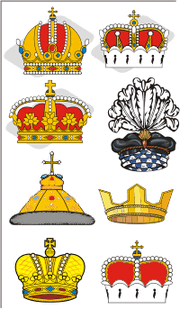
The pronoia ordened the imperial dignities and titles, linked him to the autorithy of the Basileus
After the fall of Parsian Empire, the Hellenes inherited the confusing system of the former empire, and many called maintain such offices and dignities to maintain imperial tradition inherited from their ancestors, the Basileus also considered it relevant as a means of maintaining and separate the noble lines of the imperial family, with the support of the church, the Basileus created various reforms in order to optimize and abolish certain nobility titles and with the aim of updating and deleting legacy obsolete positions, abolished a lot of administrative positions and created others, kept the noble titles and abolished others, finally, improved both administrative and efficiency to every level of nobility both military and civil offices, such reform is called "The Pronoia"
The pronoia consesión consisted of the administrative offices and honorary character dignities according to his office and position in the imperial court, could lose it in different ways to change certain concessions, these charges are given for prizes and exclusive rights without violating imperial authority, reformed prize dignities and offices in honorific titles also reformed the importance of titles of nobility and power today, creating a complex system itself but more clean for administrative issues. The Pronoia is inspired by both Hellene customs and ideas of Aquitanian federalism maintaining certain habits of Parsians as dignities and offices and all the solemnity that that entails
the measure caused the total renovation of the aristocratic and noble system of the country, and caused marked differences with foreign states admitting the aristocratic titles, as many titles provoked not only that they were indirectly linked to moral discipline and the emperor, but also many dignities and offices were abolished or could be lost, trades and hereditary honors were lost forever (as well as the confusion)
Many nobles protested and demanded the right to veto the measure senate, but the emperor managed to negotiate with the church and so approve, caused multiple replicas which were appeased with the passing of the years and so the emperor maintained his authority, the ideology of imperialism is radicalized and autorized thanks to the patriarchate to the "universal mission of the basileus of guide all the Ruthenians, and the imperial authority is the manifestation of divine power and only the basileus can designate some titles and dignities.
War with Mauri and Imperial Identity(3229-3230)[]
Before the formation of Ruthenian Empire, the defunctParsian Empire have several allies in the north, some refugees created the Kingdom of Mauria as a result of diplomatic actions of Counts of Arcadia, and began diplomatic hostilities with the new Empire of Ruthenia, Konstantinos sent a diplomatic representative to Arcadia and begins diplomatic relations with the Maurian Leaders, after ten years of tough tensions between the two countries, the Mauryans claimed for the return of the Parsians to their territory, something the Ruthenes not accepted, and conversely, the Mauryans invited to participate and be part of the new Orthodox Empire, the count of Arcadia found the invitation as "absurd" and declared war in 3229, the Ruthenes reacted quickly and the declaration of war was made in March 3229, war that lasted 4 months Arcadia was bombing and killed 700,000 people, the president of Mauri soon surrendered in 3230 and the annexation of Mauria statement as a principality of the Empire, granting certain concessions. in the 3232 administrative reform in the principality, with Hellenized most of the region and by extending the imperial administration to rule and renamed most of the region with Selloi names, except for some people who kept his Maurian identity (since its annexation in 3220, only the capital changed its name, but administrative priorities and national consciousness of later years forced the rule in the total turnover of the names of the region)
After the conquest of Mauri, the Principate is renamed as Thracia appointing to Manuel Bragationi as the first Exarch of the Principate, and forced the emperor to make a major administrative reform at regional and local levels, creating numerous administrative positions and bureaucratic, causing confusion to foreigners in addition to all but the mayors respond and are appointed by the emperor himself,
Reign of Theodoros(3230 - Present)[]
In February of 3230 Konstantinos died for unknown circunstances and his son, Theodoros Daskalaris assumes as New Basileus of the Empire called himself as Theodoros I, with the first goal is the Thracia economic stability and continued diplomatic relations between the various nations of the region, travelled to Königsberg signing the treaty between the Empire and the The Union Federation
Another of the political objectives is finish the work of his father: The full social and political structure of the empire and consistently set national identity among the various ethnic groups in the territory and a greater overhaul of the military institutions of the empire.
The Union with Aquitanian Royal Family (3234)[]
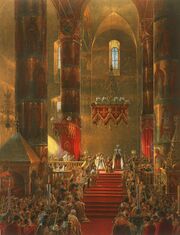
The Coronation of the Basileus and the Basilissa Elizabeth-Maya Hoheinstenburg
In 3234 the Basileus Theodoros I married with the Princess of Aquitanian Empire Elizabeth Maya Hohensteinburg-Collette after a visit of the emperor to Konigsberg naming his brother Michael as ambassador of Ruthenia in Aquitaine territory, Theodoros met Elizabeth after months married in Hagia Triada in the Ruthenian capital of Auronopolis according to the Orthodox rite of imperial marriage, Elizabeth and was baptized Orthodox according to the canonical laws of the empire, changing its name to Isavella, the first foreign-born Ruthenian Empress
This wedding was celebrated with great enthusiasm by the authorities and the Ruthenian nobility because close relations between the two countries, were invited the chief nobles of both countries, highlighting Michael Daskalaris, Irene Kantakouzina, the Basileomitor of Theodoros, The Kaiser of Aquitania Friedrich II, the Prince of Prussia Friedrich Alexander, his wife Marie Elisabeth von Weier and the brothers of Maya: Alexis Wilhelm, Friedrich Wilhelm and Alexander Hohensteinburg
The presence of the new empress was treated with much surprise among the nobility and the Ruthene people but soon showed great enthusiasm and a lot of willingness to learn the Hellenic language and customs, under their influence various study centers were created and there was a great approach with foreign institutions, helping to modernize the country, Theodoros modernized the imperial council and modernized the army and the administrative system,creating a new subject called Megalopolis raising that category to the cities of Neapolis and the Imperial Capital of Auronopolis.
Communist Crisis Intervention (3247-3254)[]
Main Article: Communist Revolt in Arendale
Since the formation of the Council of Centau the prime minister of Union of Arendale claims for the union help in the civil war between the National Peoples Army and the Arendelean government, the Basileus in a attempt of weak the communist influence in the international matters, declares to his Polemarchos Daniel Mantzaris to a emergency council of the Imperial Council of National Defense in Auronopolis, the Polemarchos and the members of the council declares the intervention and the help of the Arendale monarchy sending 35.000 troops and the Ruthene Special Corps commanded by Isidoros Lamprakis as chief of the expedition, they landed in Golden Rainbow a two months later thanks and by transport ships and arrived in Excel city where they took the initiative Ruthenian Special Forces Regiment soldiers parachuted or beach headed in the city. recovering 10 kilometers of the land and securing the west flank of the city. giving relief to the Arendale army.
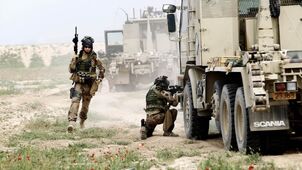
Ambush in Bel Passa
The Ruthene forces was the only hope for the forces in excel, in two months the union army soldiers in Excel were waiting for the Eagles, after two monts the Epeideskoi arrived simulatneously the WB forces launched a beachhead in Qunatabel,as with the Erusians in Gulfport. This was Operation Ascent in Arendale. After the Operation the Ruthene forces joined woth daleans and launched offenseves to take The West coastline, involving the city of Monterrey, simulatanouelsy the Bel Passa battle raged in the south resulting to less than 5000 deaths. In the following months the Ruthenes and Daleans guarded the west flank from incursion. This is known as the battle of The West flank, where Isidoros Lamprakis died with many other soldiers. The attack was similar to the battle of the bulge. Then both gaian and aquitanian support pushed up to Bloastion city, when a peace treaty was finally formed.
The lost in Bel Passa was a mayor setback to the joint Dalean-Ruthene army and the Imperial Government suffered numerous protests around the peninsula, in Auronopolis, 30,000 citizens marchs in direction to the Great Palace in search of answers for the intervention of foreign matters and the fear of a new dictatorial government based in the recently ruthene monarchy, Theodoros I intervene in a national chain which promises the return of the troops and major reforms to ensure the freedom of individuals, creating numerous reforms ethnic freedoms imperial protection and the establishment of a possible referendum to create a constitution, reformed the judicial system and encouraged the military support to their "families struggling for freedom in Arendale"
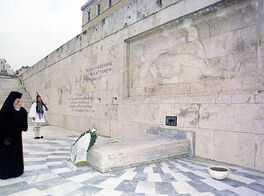
Isidoros Lamprakis died during the Intervention of Arendale
After seven years of war, the Ruthene troops finally return home after a peace treaty between the Arendale government and the NPA, many ceremonies military burial occurred, the new patriarch Konstantinos VII appointed Lamprakis as the first martyr of Ruthenia and the Basileus decreed national mourning for the loss occurred abroad, despite the Solomonic result, intervention in the conflict was seen as negative among people for the deaths that were considered unnecessary, the Basileus excused his act as a method of "approach and obligation as an enemy of tyranny and member of the council", the imperial council advised against eventual social instability, The Basileus promised that their deaths would be example for greater caution in their actions, thereby reformed the army and strengthened the defenses, built an aircraft carrier and promised legislative changes and the construction of "the tomb of the unknown soldier" in honor of the soldiers who fell in battle, finished in 3255 in Auronopolis
Economic Crash (3263- 3274)[]
A huge economic crash provoqued a sudden and unexpected shortage of supplies and materials in all the world market, affecting almost every Ruthene corporation, soon before the north borders suffered a earthquake who caused the destruction of a corporation and the death of near 10.000 people and the relocation of 32.000 people, the earthquake and the economic crash was a huge blow to the ruthene economy.
Due to the economic crash, the ministry of Finance and the ministry of Commerce and industry intervene in the local market helping the buying of assisting in the purchase of necessary materials, promoting the work and the construction of other corporations needed to help the country and the market to solve the crisis, the Basileus asked advice to other countries, concluding that it is a global problem that affects not only the planet but other planets as Kebir Blue.
the imperial intervention helped to boost the Ruthene economy and build other 4 corporations solving the problem in the short term, promoting the high tech services and the production of Oil corporations, after the coronation of Alexandros I, the country suffered another economic debacle in part by the urgent need for specialists in high technology, for which the imperial government took serious measures of foreign training in high technologies and was forced into closure 4 unproductive industries and generate a "natural transition "of specialists to more productive firms, letting the" invisible hand "do the rest: the measures tested positive in the imperial coffers and stabilized the economy, adding further growth of the economy and local optima training of engineers in various areas of innovation.
Geography[]
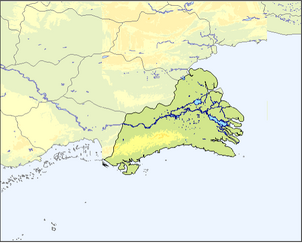
Ruthenia is located in Southern part of Eridana and comprises all the soutwest peninsula in the region of Bandria Granda, a number of islands comprehends the formal territories of Ruthenia, including the Arcadian Archipielago and the Island of the autonomous and monastic state of Mount Agios
The country's total area is 301,230 square kilometres (116,306 sq mi), of which 294,020 km2 (113,522 sq mi) is land and 7,210 km2 (2,784 sq mi) is water. Including the islands, Ruthenia has a coastline and border of 7,600 kilometres (4,722 miles) on the Sea of Marmora, Aegean, Morandan seas (740 km (460 mi)), and borders shared with Colomo, Misoto and Olenda. Thracia is considered part of the Ruthenian territories and bordered in the west part of the peninsula.
Ruthenian terrain is distributed roughly equally between hilly and grasslands territories. There little mountains and many hills dominate the southof the country, there many sacred mountains in Ruthenia, like Agia Lavria and Agia Platea in Parapotamia, Ruthene's geographical diversity has led to an accompanying diversity of flora and fauna. features another grassland range in the south of the country, spreading across the region of Kandokia Minor and Kandokia Maior; this area is covered with vast, thick, ancient forests, including the famous Dadea forest in the Avrias regional unit, in the far southeast of the country.
The terrain of central part of the country, with the region of Transpatrion at its heart, consists chiefly of hills traversed by the rivers. Mountains dominate the southern third of Ruthenia. Dinaric Alps stretch in the west and the southwest following the flow of the rivers of Sava, Drava, Koita and Danuba.
Extensive plains are primarily located in the regions of Ruthenia and Thracia. They constitute key economic regions as they are among the few arable places in the country. Rare marine species such as the Pinniped Seals and the Loggerhead Sea Turtle live in the seas surrounding mainland of the country, while its dense forests are home to the endangered brown bear, the lynx, the Roe Deer, Wild Goat and the Golden Eagle, this last one inspired many Selloi legends and histories of the people of the Peninsula, also as many holy symbols of the Ecumenical Patriarchate of Auronopolis.
Hydrology[]
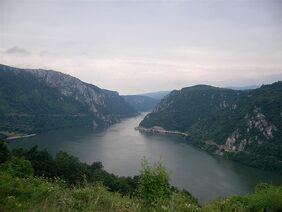
Danuba River in northern Ruthenia
Almost all of Ruthenia rivers drain to the Sea of Marmora, by way of the Danuba river. The Danuba, second largest Bandria Granda river, passes through Ruthenia with 588 kilometers (21% of its overall length) and represents country's largest source of fresh water. It is joined by its biggest tributaries, the Imvrassia (longest river entirely in Ruthenia with 493 km of length), Sava and Drava rivers.
Due to the configuration of the terrain, natural lakes are sparse and small; most of them are located in Cinspatrion, like the glacial lake Palatea (covering 16 square kilometers, country's largest natural lake) or numerous oxbow lakes along river flows (like Unaris and Hellespontea rivers). However, there are numerous artificial lakes, mostly due to hydroelectric dams.
Abundance of relatively unpolluted surface waters and numerous underground natural and mineral water sources of high water quality presents a chance for export and economy improvement; however, more extensive exploitation and production of bottled water began only recently.
Environment[]
After its quick industrial growth, Ruthenia took a long time to confront its environmental problems. After several improvements, National parks cover about five percent of the country, specially in Thracia. The air pollution remains a severe problem, especially in the industrialised south, reaching the tenth highest level worldwide of industrial carbon dioxide emissions during the Enosis period. Extensive traffic and congestion in the largest metropolitan areas continue to cause severe environmental and health issues, even if smog levels have decreased dramatically since the fall of Parsia, and the presence of smog is becoming an increasingly rarer phenomenon and levels of sulphur dioxide are decreasing.
With 29.1% of its territory covered by forest, Ruthenia is considered to be a middle-forested country. The most common trees are oak, beech, pines and firs.

The Golden Eagle is a popular symbol of Ruthenian Empire, particulartly in the capital
It's abundance of mountains and rivers make it an ideal environment for a variety of animals, many of which are protected including wolves, lynx, bears, foxes and stags. Mountain of Tarea in western Ruthenia is one of the last regions in Eridana where bears can still live in absolute freedom. Ruthenia is also home to about 380 species of bird, including the golden eagle, the great bustard, the corn crake and the pochard. In Carea Barkali, there are over 300 bird species on just a few square kilometers.
There are 377 protected areas of Ruthenia, encompassing 4,947 square kilometers or 6.4% of the country. Those protected areas include 5 national parks (Illyrios, Tarea, Alassan, Alabonia and Sarolation), 15 nature parks, 15 "landscapes of outstanding features", 61 nature reserves, and 281 natural monuments.
Climate[]
The climate of the Ruthene mainland is a mixture of Mediterranean and mountainous. Much of the territory receives snow in winter and is warm during the summer months.
The climate of Ruthenia is primarily Mediterranean, featuring mild, wet winters and hot, dry summers. This climate occurs at all coastal locations, including Auronopolis, Massalia, and other towns around the country, inside the climate is more template and far west in Bothinia is more dry. Conditions on peninsular coastal areas can be very different from the interior's higher ground and valleys, particularly during the winter months when the higher altitudes tend to be cold, wet, and often snowy. The coastal regions have mild winters and warm and generally dry summers, although lowland valleys can be quite hot in summer. Average winter temperatures vary from 0 °C (32 °F) on the north to 12 °C (54 °F) in Spireos, like so the average summer temperatures range from 20 °C (68 °F) to over 30 °C (86 °F).
Thanks to the great extension of the peninsula and the mostly mountainous internal conformation, the climate of Ruthenia is highly diverse. In most of the inland northern and central regions, the climate ranges from humid subtropical to humid continental and oceanic. In particular, the climate of the Koronia valley geographical region is mostly continental, with harsh winters and hot summers.
Phytogeographically, Ruthenia belongs to the Boreal Kingdom. According to the World Wide Fund for Nature and the Environment Agency, the territory of Rumenia can be subdivided into six ecoregions: the Aurania deciduous forests, Pindus Mountains mixed forests, Sozopolis mixed forests, Rhodope montane mixed forests, Aegean and Western Thracian sclerophyllous and mixed forests and Ronopan Mediterranean forests.
Government & Administration[]
Main Article: Imperial Government
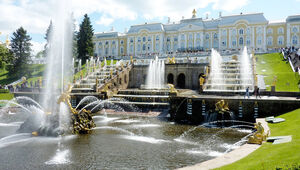
Palace of Blanchernas in Auronopolis
Ruthenia is controlled by the Emperor ruling in a Imperial Autocracy and the figure of the emperor is called Basileus by the people, the autocracy consist of where all the power and wealth is controlled and distributed by the Basileus himself.
The origin of his power was regarded as having divine origin because is power is given by God through the Ecumenical Patriarchate The reigning Basileus is responsible for naming almost all government positions, starting with the prime minister and cabinet government, subsequent reforms also are related to appointments and approval of specific legislative charges, subsequent reforms charges will almost entirely independent judicial and ecclesiastical duties, responsible to the court of Cassation and patriarchy respectively.
The Emperor[]
Main Article: Basileus
The Basileus, the ruler and divinely ordained, is the Head of State and holder of the Executive power, and beneath him a multitude of officials and court functionaries operated the administrative machinery of the state. The center of the executive power of the country was the person of the Basileus himself. The Prime minister have certain administrative and executive tasks, The fundamental laws of Ruthenia described the power of the Basileus as "Autocratic and unlimited" A key component of state power was the prestige of the Imperial institution and its long antiquity since Kormenian times, the Basileus and the Ruthene administrative machinery is a succesor of Parsian and Kormenian times like the ceremony and the granting of both honorific titles and valuable offices was therefore extensive and elaborate. The Basileus only have two limitants: The emperor and his consort must both belong to Orthodox Church and he must obey the laws of sucession and the acts of the legislative power. Beyond this, the power of the Basileus is almost limitless.
The official residence of the Imperial Family is the Palace of Blanchernas in Auronopolis, other residences are the Placidia Palace in Neapolis, in Thracia.
The Ruthene bureaucracy had a distinct ability for reconstituting itself in accordance with the Empire's situation. The elaborate system of titulature and precedence, which gave the court prestige and influence, makes the imperial administration look like an ordered bureaucracy to modern observers. Officials were arranged in strict order around the emperor, and depended upon the imperial will for their ranks. There were also actual administrative jobs, but authority could be vested in individuals rather than offices.
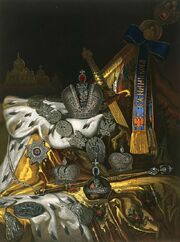
The Ruthene Imperial Regalia
Civil service constituted the clearest path to aristocratic status, but, the civil aristocracy was rivalled by an aristocracy of nobility. The Ruthenes inherit the Parsian politics and the competition between the civil and the military aristocracy. During this period, the Basileus undertook important administrative reforms, including the creation of new courtly dignities, offices and awards condecorations.
The Imperial family have numerous properties and crowns and robes, The Holy Crown of Saint Stephanos. blessed by the Ecumenical Patriarch. The court jeweller Antonios Chrisostomou made the Great Imperial Crown for the coronation of Theodoros in 3230. The beautiful crown reflects Antonios's skilled workmanship. It is adorned with 4936 diamonds arranged in splendid patterns across the entire surface of the crown Bordering the edges of the "mitre" are a number of fine, large white pearls. The crown is also decorated with one of the seven historic stones of the Parsian Diamond Collection: a large precious red spinel weighing 398.72 carats (79.744 g), which was brought to Ruthenia by Libero Ingrassia, the Ruthene envoy to Kolomea in 3222. It is believed to be the second largest spinel in the world.
The use of many pictures is also typical of Selloi crowns. When the intersecting bands were added to the corona selloina during the rule of Konstantinos, who had been brought up in Auronopolis, the bands were decorated just as the corona graeca was, perhaps with the intention of imitating the orthodox saints crowns. only the imperial family can use the purple color by law.
Legislative powers are exercised by a 540-member elective bicameral chambers called The Senate and Chamber of Deputies, both chambers conformed the States General of Ruthenia. Statutes passed by the States General are promulgated by the Basileus. the deputies elections are held every ten years and the elections are confirmed by the Basileus and some nobles, the elections are presented by notable nobles of diversal thematas and eparchias.
The Imperial Council[]
See Also:Council of Ministers of Ruthenia
The Imperial Council is the cabinet and the main branch of the Imperial Government, the Basileus created the Council of Ministers to assist the Basileus and the prime minister in the supreme administration, under a chairman of the council and create numerous charges and offices of central administration and functioned as a policy making cabinet with its Chairman acting as Prime Minister.
The Position of Prime minister as the Ruthenia head of government belongs to the person of most confidence of the Imperial Council and selected by the Basileus The prime minister chooses a cabinet and they are formally appointed by the monarch to form the Imperial Government.
The Actual Prime Minister is Argirakis Kampouridis. This council consists of all the ministers and of the heads of the principal administrations. The "de facto" head of the government is the Prime Minister The ministries were as follows:
- Ministry of the Imperial Court
- Ministry of Foreign Affairs
- Ministry of Defence
- Ministry of Navy
- Ministry of Finance
- Ministry of Commerce and Industry
- Ministry of Internal affairs
- Ministry of Education and Science
- Ministry of Religious Affairs
- Ministry of Agriculture and State Assets
- Ministry of Communications and Mass Media
- Ministry of Justice
- Ministry of National Enlightenment
- Ministry of Health
- Ministry of Natural Resources and the Environment
- Ministry of Energy
- Ministry of Culture
- Ministry of Sports
- Ministry of Agriculture
- Ministry of Principate Development
The Senate[]
Main Article: States General of Ruthenia
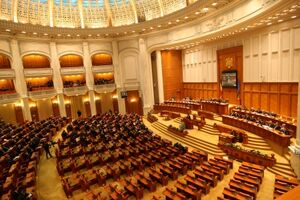
The Chamber of Deputies
The Senate was established during the Enosis and confirmed by Konstantinos I.
Consisted of 548 seats and 34 members appointed for life by the Basileus on the advice of the Prime Minister. Its wide variety of functions were carried out by the different departments into which it was divided. an audit office; one of its departments fulfilled the functions of a heralds' college. It also had supreme jurisdiction in all disputes arising out of the administration of the Empire. It was chaired by the Proboulos. He served as the link between the sovereign and the Senate and acted, in the Basileus own words, as "the sovereign's eye".
The Senate have a legislative authority as an honorary council with titular members. Most of the bills passed by the Lower House required the consent of the The Senate, except for the government budget and military recruitment. The Membership was attained by inheritance or can be sold it, by appointment or by an ecclesiastical role in the Church.
The upper house comprised:
- Notable Aristocratic Members of the Empire
- Representative of Ecumenical Patriarch of Auronopolis and the Archdiocese of Thracia
- Ruthene nobles appointed as hereditary peers by the Basileus
- Ruthene citizens appointed as life peers.
To be a member of the senate, you must be elected by the Basileus as "honourable member of the Gerousia" and resign of their political party (if the candidate is member of one) and make a oath of fidelity and "search the common good for the empire", after that the basileus granted the title of "Zevgos" to the new member.
The Chamber of Deputies[]
Main Article: Chamber of Deputies
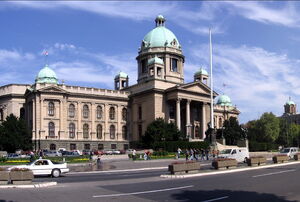
The Parliament of Ruthenia in Auronopolis
The Chamber of Deputies is the lower house of the parliament, where discussion of proposed legislation and review of the actions of the cabinet takes place, is composed of 514 delegates of various provinces and newly political parties leader by a Omili̱tí̱kas (chief speaker) elected by the chamber himself.
Both the Senate and the Chamber of Deputies itself have the right to propose legislation; Chamber of Deputies discusses it and, if adopted by a majority, sends it on to the Senate. Review of the actions of the cabinet takes the form of formal interrogations, which may result in motions urging the cabinet to take, or refrain from, certain actions. No individual may be a member of both parliament and cabinet, except in a caretaker cabinet that has not yet been succeeded when a new Chamber is sworn in.
The Chamber of Deputies is also responsible for the first round of selection for judges to the Court of Cassation in the Empire. It submits a list of three names for every vacant position to the Government.
In the Chamber of Deputies, the Suffrage was extended to all males aged 24 or older who had resided in one place for at least one year, and the principle of "one man one vote" was implemented in furtherance of universal, direct, equal, and democratic suffrage. While this was perhaps an admirable advance in terms of democratic theory, the inevitable result was the splintering of the Council into numerous factions, principally geographical and ideological, which damaged its function as a working legislature.
Judicial System[]
Main Article: Judicial System of Ruthenia
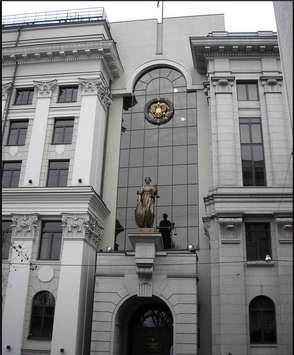
Supreme Court of Ruthenia, Auronopolis
The judicial system of Ruthenia, was established by the Konstantinos I, by a Basilika Decree of 20 November 3220. This system — based partly on Kormenian civil law and Parsian common law models — was built up on certain broad principles: the separation of the judicial and administrative functions, the independence of the judges and courts, the publicity of trials and oral procedure, the equality of all classes before the law, principles based in foreign and national theorists and part of the modernization of the judicial system, these principles are protected by imperial law in the Constitution of Ruthenia
The establishment of a judicial system on these principles constituted a major change in the conception of the Ruthene state, which, by placing the administration of justice outside the sphere of the executive power, ceased to be a despotism, the further imperial reforms in 3250 made a overhaul and a modernization of Judicial system, changing almost everything in civil and criminal law and separating the ecclesiastical and civil judges in different competence, creating the Prosecutor General of Ruthenia and the Imperial Court of Ruthenia as the main supervisor of the Imperial law.
Administrative Divisions[]
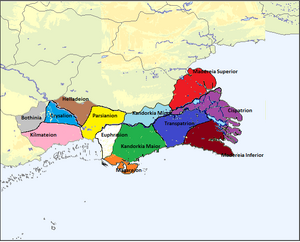
Provinces (Eparches) of Ruthenia
Main Article:Ruthenian Administrative Divisions
For the purposes of administration, Ruthenia was divided into 6 governorates (Thematas) and 13 provinces (Eparches). Vassals and Principates of the Empire included the Grand Principate of Thracia as a Autonomous Principate and his regions and thematas are incorporated to the imperial administration.
The first level of government is constituted by the municipalities (δήμοι, dímoi; sing. δήμος, dímos), which have resulted from merging several former municipalities and communities of the defunct Parsian Empire. They are run by a mayor (δήμαρχος, dímarchos) and a municipal council (δημοτικό συμβούλιο, dimotikó symvoúlio), elected by the people of the dimos every 10 years. The municipalities are further subdivided into municipal units (δημοτικές ενότητες, dimotikés enótites) and finally into communities (κοινότητες, koinótites). Although communities have their own councils, their role is purely advisory to the municipal-level government.
The second level is composed of the Provinces (περιφέρειες, periféreies; sing. περιφέρεια, Eparches), run by a regional governor (περιφερειάρχης, Hypatos) and a regional council (περιφερειακό συμβούλιο, perifereiakó symvoúlio), being assigned by the Basileus. The Provinces are divided into regional units (περιφερειακές ενότητες, perifereiakés enótites), usually but not always coterminous with the former prefectures. Each regional unit is headed by a vice-regional governor (αντιπεριφερειάρχης,Antyphatos), drawn from the same political block as the regional governor. The only exception is the territory between the capital and its surroundings, which is governed by the mayor of Auronopolis (titled as Megadimarchos) having powers as provincial governor inside the imperial territory, the megadimarchos is elected by the Basileus himself.
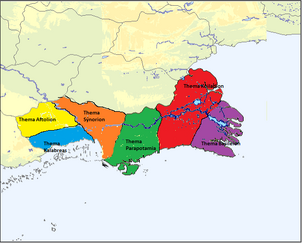
Governorates (Thematas) of the Empire
The third level is composed of the new decentralized governorates (αποκεντρωμένες διοικήσεις, Thematas), comprising two or three regions, run by a secretary of the Imperial Court or subordinated called Domestikos, assisted by an advisory council drawn from the regional governors and the representatives of the municipalities. the only excepcion is the Thema Basileion, the administration falls in a Secretary called Megadomestikos (δομέστικος), this because to their size and proximity to the emperor.
Since 3234 with the reform of Theodoros, the Thema Auropolión ceases to exist and a new exclusive range created for the capital of the empire, called Megalopolis or Capital Cities (πόλη) these cities have a own representation and administration dependent on the Basileus the city of [Neapolis]] is elevated to Megalopolis and the mayor becomes a direct subordinate of the emperor.
- The provinces in Ruthenia are: Madereia Superior, Madereia Inferior, Cispatrion, Transpatrion, Kandorkia Maior, Kandorkia Minor, Euphrasion and Megareion.
- The provinces in Thracia are: Parsianion, Klímateion, Helladeion, Crysalion and Bothinia
- The cities of Auronopolis and Neapolis is considered "Megalopolis" or cities with own representation in the Ruthenian Parliament and own administration under Basileus consideration.
- The Themas are: Thema Basileion, Thema Kóiladion, Thema Parapotámia, Thema Aftolión, Thema Sýnorion and Thema Protoxion, The first three are Themas located in Rumenia and the last three are localizated in Thracia
Ruthenia have one Protectorate or Principate, The Grand Principate of Thracia in the Basilika Decree of 3219 its considered a confederated state of the Empire and a Principate ( ηγεμονία; i̱gemonía) with is own administration protecting the interests of those living in and around Thracia, the administration of the principate is in charge of a Exarch (ἔξαρχος; exarchos) elected by the Basileus and can designate its own elected council secretaries sent by the empire and local governors, three Themas were created to the best imperial administration.
Local Administration[]
Alongside the local organs of the central government in the Empire there are three classes of local elected bodies charged with administrative functions:
- Agrotikós, (rural assemblies) were peasant communities, as opposed to individual farmsteads which acted as a village government and a cooperative. Arable land was divided in sections based on soil quality and distance from the village. Each household had the right to claim one or more strips from each section depending on the number of adults in the household. The purpose of this allocation was not so much social (to each according to his needs) as it was practical (that each person pay his taxes). Strips were periodically re-allocated on the basis of a census, to ensure equitable share of the land. This was enforced by the state, which had an interest in the ability of households to pay their taxes.
- Eparchiakí̱ (provincial assemblies) in all the Thematas
These bodies, one for each district and another for each province or government, were created by Konstantinos I in 3220. They consisted of a representative council (ekpróso̱pos tou symvoulíou) and of an executive board (ektelestikó symvoúlio) nominated by the former. The board consists of five classes of members:
- large landed proprietors (nobles owning 590 acres (2.4 km2) and over), who sit in person;
- delegates of the small landowners, including the clergy in their capacity of landed proprietors;
- delegates of the wealthier townsmen;
- delegates of the less wealthy urban classes;
- delegates of the peasants, elected by the Domestikos
- Dimotiko Gerousía (Municipal Senate)
All owners of houses, and tax-paying merchants, artisans and workmen are enrolled on lists in a descending order according to their assessed wealth. The total valuation is then divided into three equal parts, representing three groups of electors very unequal in number, each of which elects an equal number of delegates to the Dimotiko Gerousia. The executive is in the hands of an elective mayor and an gerousiastí̱s, which consists of several members elected by the duma. The Dimotikos Gerousia is subordinated to the Domestikos in the same way as the Eparchiaki.
Foreign relations[]
Main Article: Foreign relations of Ruthenia
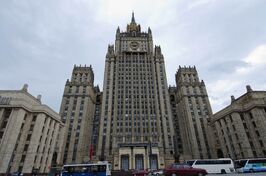
Seat of Ministry of Foreign Affairs
The Empire of Ruthenia is recognized in international law as a succesor state of the former Parsian Empire, Ruthenia has a multifaceted foreign policy, maintaining diplomatic relations with 14 countries and has 7 embassies. The foreign foreign policy is determined by the Basileus and implemented by the Ministry for Foreign Affairs.
Ruthenia is Permanent Member of The Union Federation and its part of The Union Common Market and its one of the founder member of the Council of Centau, playing a mayor role in maintaining international relations between affiliated members.
Ruthenia maintains strong diplomatic relations with Aquitanian Empire and Imperial Union of Gaia, sharing extensive and strategic relations in defense, education, culture and healthcare, the aim of Ruthenia is work together as equal partners to pursue opportunities for joint collaboration
the first Deputy Secretary-General of Council of Centau is Thomas Batatzes
Military[]
Main Article:Military of Ruthenia
 Imperial Army Leopard 2A6 HEL |
 Imperial Navy MEKO-200 HN |
 Imperial Air Force F-16 Fighting Falcon |
The Imperial Armed Forces are overseen by the Imperial Council of National Defense (Συμβούλιο Εθνικής Άμυνας), a military advisor supervised by the ministry of Defense for the Basileus and consists of four main branches:
The civilian authority for the Ruthene military is the Ministry of Defence Furthermore, the empire maintains the Ruthenian Coast Guard for law enforcement and numerous law enforcement agencies
The Empire has universal compulsory military service for males, while females (who may serve in the military) are exempted from conscription. As of 3219, Ruthenia has mandatory military service of nine months for male citizens between the ages of 19 and 45.
Law Enforcement[]
Main Article:Law enforcement in Ruthenia
During the reign of Theodoros I, the law enforcement suffered a major overhaul in all their agencies, creating branches of the civilian police, and other specialized agencies with diverse duties around the empire, the overhaul created the Imperial Protective Service, the Ruthenian Investigative Committee and other independient branches under supervision of the Ruthene Imperial Gendarmerie, these agencies proved to be effective in the crime combat and public safety around the empire.
The Ecumenical Patriarchate have is own police and protective service called Ezvones with simbolical and civilian duties in Mount Agios
Inteligence[]
Main Article:Ruthenian Bureau of Intelligence
The Hellenic Bureau of Intelligence (Ρωμαίων Γραφείο Πληροφοριών; Elliade Grafeío Pli̱roforió̱n RGP)s the national intelligence agency of the Empire. Its headquarters are located in Auronopolis. It is under the administration of a secretary appointed by the emperor under the ministry of internal affairs, the Basileus give the title of Archégos (chief of offices).
During the government of Theodoros, the Basileus created other agencies with supervision of the Bureau, the Special Communications Service being a cryptologic intelligence agency of The Ruthenian Bureau of Intelligence responsible for the collection and analysis of foreign communications and foreign signals intelligence and the MID, or Main Intelligence Directorate, It was given the task of handling all military intelligence, particularly the collection of intelligence of military or political significance from sources outside the Empire.
Economy[]

Vraykos Factory Maintenance
Ruthenia has an emerging market economy in upper-middle income range. The economy has been affected by the global economic crisis in all the planet. As the government was fighting effects of crisis the public debt has doubled in since the government of Theodoros I, with the help of international loans and a strong economic politic advised by Gaian economists, the empire have a stable economy, being considered as a developed country with high standards of living. Its economy mainly comprises 33 corporations and industries. Since the Ruthenian-Maurian War many employments are used for military uses and the labor fell sharply, forcing the closure of some industries, the finance minister along with several aggressive tax reforms are focused on developing a stable employment and financial service.
Labor force is 8,256,325 million, of whom 58.6% are employed in services sector, 21.9% are employed in the agriculture and 19.5% are employed in industry. The average monthly net salary was 350,0 Dolleuros. The unemployment its considered only a minor problem, because the imperial reforms the index is 6.9%.
Ruthenia has an unfavorable trade balance: imports exceed exports by almost 30%. Ruthenia exports, however, recorded a steady growth in last couple of years reaching 36.77B SC in 3240. The country has free trade agreements with the Thracia industries, a preferential trade regime with The Union CM, a Generalized System of Preferences with the Aquitanian Empire industries and other members of the common market.
Industry[]
Main industrial sectors include: Electric Components, Car Engines, Newspapers and a strong High Tech Corporations focused in Factory Maintenance, since the Economic clash in 3267, the Imperial Government shut down some inefficient industries like weapons and ammunitions and focusing in the creation of more jobs and more High Tech Specialists, in the present, the empire have 36 corporations and 7 Country Controlled Public Corporations, mainly based in High Tech Technologies.
Transport[]
Ruthenia have 32,552 miles of Highways and roads and 13,045 train roads, the most important railroads include the (Egnatia Odos way, that connects the Capital with Thracia; and other coastal highways.
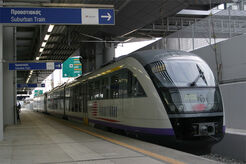
Flaviopolis Metro System
Important projects that are currently underway include, upgrading unfinished sections of motorway on the A1, the construction of roads in Auronopolis and Central Ruthenian and inter conected railway Thracia/Auronopolis.
The Auronopolis Metropolitan Area in particular is served by some of the most modern and efficient transport infrastructure in the continent, such as the Auronopolis International Airport, the privately run Attiki Odos motorway network and the expanded Flaviopolis Metro system.
Most of the Ruthenian islands and many main cities of the Empire are connected by air mainly from the two major Imperial airlines, Ruthenian Air and Oegea Airlines. Maritime connections have been improved with modern high-speed craft, including hydrofoils and catamarans. Railway connections play a main role in the empire than in many other Eridanian countries, but they too have also been expanded, with new suburban/commuter rail connections, serviced by Proastiakos around Auronopolis, towards its airport, A modern intercity rail connection between Flaviopolis and Cristopolis has also been established, while an upgrade to double lines in many parts of the 2,500 km (1,600 mi) network is underway. International railway lines connect Ruthenian cities with the rest of the continent.
Telecomunications[]
Modern digital information and communication networks reach all areas. There are over 10,000 km of fiber optics and an extensive open-wire network. Broadband internet availability is widespread in the Empire: there were a total of 1,252,653 broadband connections as of early 3220, translating to 20% broadband penetration. According to 3220 IRSTAT data, 23,6% of the households used the internet regularly and of which 94,8% of them had broadband connection. Internet cafés that provide net access, office applications and multiplayer gaming are also a common sight in the country, while mobile internet on 3G cellphone networks and Wi-Fi connections can be found almost everywhere. 3G mobile internet usage has been on a sharp increase in recent years, with a 340% increase between August 3218 and August 3220
Telecommunications[]
Fixed telephone lines have 89% of households in Ruthenia, and with about 9.8 million users the number of cellphones surpasses the number of total population of Ruthenia itself by 35%. The largest cellphone provider is Ruthenia Telecom with 5.65 million subscribers, followed by Telenor with 3.1 million users and Vip mobile with just over 1 million. Computers have 59.9% of households and 55.8% have internet connection (43.4% have a broadband connection). Some 58% of households have cable TV, which is one of the highest rates in Eridana. almost every house have at least one digital television.
Maritime Industry[]
The shipping industry is a key element of Ruthene economic activity dating back to Parsian Times. Today, shipping is one of the country's most important industries. It accounts for 4.5% of GDP, employs about 160,000 people (4% of the workforce), and represents 1/3 of the country's trade deficit.
The basis of the modern Ruthene maritime industry was formed after Ruthene-Maurian War when Ruthene shipping businessmen were able to amass surplus ships sold to them by the foreigners government and novice helps.
the Ruthene merchant navy is the largest in the world at 16.2% of the world's total capacity, up from 15.96% in 3220.
In terms of total number of ships, the Ruthene Merchant Navy stands at 4th worldwide, with 3,150 ships (741 of which are registered in the empire whereas the rest 2,409 in other ports). In terms of ship categories, Ruthene ranks first in both tankers and dry bulk carriers, fourth in the number of containers, and fifth in other ships. However, today's fleet roster is smaller than an all-time high of 5,000 ships in the late 1970s. Additionally, the total number of ships flying a Ruthene flag (includes non-Ruthene fleets) is 1,517.
Tourism[]
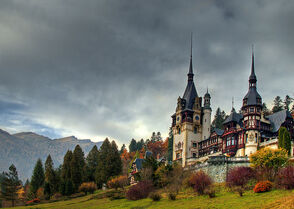
Pales Castle in Basileion Themata
Tourism focuses on the country's natural landscapes and its rich history and is a significant contributor to the Ruthene economy. In 3250, domestic and international tourism generated about 4.8% of gross domestic product and 5.8% of the total jobs (about half a million jobs). Following commerce, tourism is the second largest component of the services sector. Tourism is one of the most dynamic and fastest developing sectors of the economy of Ruthenia and is characterized by a huge potential for development.
According to the Imperial , Ruthenia is one of the fastest growing country in White Giant in terms of travel and tourism total demand, with a yearly potential growth of 8% from 3200 to 3250. The number of tourists grew from 1.8 million in 3220 to 3.6 million in 3250. Similarly, Ruthenia registered 10 million overnight stays by international tourists, an all-time record, but the number for 3250 is expected to increase even more. Tourism in Romania attracted $400 million in investments in 3245.
Over the past few years, Ruthenia has emerged as a popular tourist destination for many Eridanians (more than 60% of the foreign visitors in 3250 were from ED countries),thus attempting to compete with other popular countries of the region. Destinations such as Orotal Mountain, Massalia, Auronopolis, The Decadonnesse archipielago and the numerous islands are among the most popular attractions during summer. During winter, the skiing resorts along the Valea Mountains and Poiana Basin are popular with foreign visitors. Most of Ruthenia's national parks have arrangements for outdoor activities with a network of marked paths and trails and overnight accommodation in either staffed lodges or local guesthouses.
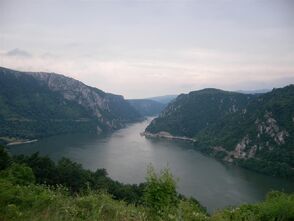
The Iron Gate of Ruthenia
For their medieval atmosphere and castles, Ruthene cities such as Tortossa and Syrrakion are popular for foreigners. Rural tourism, focusing on folklore and traditions, has become an important alternative recently, and is targeted to promote such sites as Brannea and the old cities of Kormenia, the Painted churches of Northern Maldova, the Wooden churches of Orotal, or the Merry Cemetery in Maramureș County. Other major natural attractions, such as the Danuba Delta, the Iron Gates, Scartorata Cave and several other caves in the Orotal Mountains have yet to receive great attention.
In terms of tourism potential, Ruthenia benefits from splendid cities, scattered on the smooth plains or high peaks. These include Akragia, a city built by Slavians, with cobblestone streets and colorful houses. The Almodian Castle, one of the most important monuments of Gothic architecture in Cinspatria, can be visited in Hunedoara.
The Ruthene seaside is the most developed tourist area of Ruthenia. In 3250, Ruthenia's Marmora Sea seaside was visited by 1.3 million tourists, of whom 40,000 were foreign. The shore is very varied, formed by slightly wavy shapes, with emphasized capes and deep bays extending into the Dobrea valleys, with cliffs, beaches and sand cords. In Ikonion one can see the sculptures of Konstantinos Brannas, a Ruthene sculptor with overwhelming contributions to the renewal of plastic language and vision in contemporary sculpture.
Currency[]

Symbol of the Ruthene Drachma, Ruthenia's currency
The official currency of all the empire is the Drachma (RDC) and the central bank is National Bank of Ruthenia The Auronopolis Stock Exchange is the only stock exchange in the country, with market capitalization of $8.9 billion, other currencies accepted are the Dolleuro as the international currency in interplanetary exchanges.
Since the fall of Parsian Empire, the people and peasants of the country used gold coins and some barter exchanges, since the instalation of the empire, the Minister of Finance Yiannis Lamprakis installed the Dracma as the oficial and imperial currency of the Empire.
The first issue of coins minted in 3217 consisted of holed aluminium 5-, 10- and 20-lepta pieces, with 50-lepta, 1-, 2-, 5- and 10-drachma pieces in cupro-nickel. A silver 20-drachma piece was issued in 3219, replacing the 20-drachma banknote. Coins in denominations from 50 lepta to 20 drachmae carried a portrait of Michael Auronopoulos. New coins were introduced in 3220, ranging from 50 lepta to 10 drachmae, depicting Konstantinos I. A 20-drachmae coin in cupro-nickel with an image of the Palace of Blanchernas on the obverse was issued in 3220. In the latter part of 1973, several new coin types were introduced: unholed aluminium (10 and 20 lepta), nickel-brass (50 lepta, 1 drachma, and 2 drachmae) and cupro-nickel (5, 10, and 20 drachmae). These provisional coins carried the design of the double eagle symbol on the obverse, and used the country's new designation as the "Basileia ton Ellinikon", replacing the coins also issued in 3220 as the Parsian Empire. Cupro-nickel 50-drachmae coins were introduced in 3219. In 3220, nickel-brass 50-drachma coins were introduced, followed by copper 1- and 2-drachma pieces in 1988 and nickel-brass coins of 20 and 100 drachmae in 3221. In 3230, a set of 6 themed 500-drachma coins was issued to commemorate the Enosis in 3217.
Space exploration[]

Hyperion is the first Spacecraft of Ruthenia
Ruthene achievements in the field of space technology and space exploration are traced back to Kostas Efstratiadis, the father of theoretical astronautics. His works had inspired leading rocket engineers, such as Nikos Dounias, Emmanouil Anemoyiannis, and many others who contributed to the success of the creation of a space program to Ruthenia.
In 3261 the first White Giant-orbiting artificial satellite, Lanada 1, was launched; in 3263 the first human trip into space was successfully made by Trifonas Digenis. Many other Ruthene space exploration records ensued, including the first spacewalk performed by Alexios Leontopoulos, and beyond travels to other planets as Kebir Blue and Golden Rainbow
After the success of Lanada 1 and the construction of the Hyperion, the first spaceship of the empire, the imperial government boostened the space industry in commercial activities and international cooperation.
Religion[]
Main Article:Orthodox Church and Religion in Ruthenia
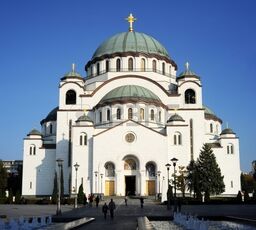
Cathedral of St Sebasteia, Auronopolis
The Ruthenian Empire state religion is Orthodox. Its head is the Basileus, who held the title of supreme defender of the Church. besides of the title and the responsibility, he did not determine the questions of dogma or church teaching or made appointments.
The principal ecclesiastical authority in the empire is the Ecumenical Patriarch, the head and Procurator of the Holy Synod. The Patriarch was one of the council of ministers and exercised some powers in ecclesiastical matters in the Parliament. The empire considered the Orthodoxy as the oficial relgion while guaranteeing freedom of religious belief for all, except that certain restrictions were laid upon the pagans. According to theIRSTAT an estimated 89% of Ruthene citizens identify themselves as Orthodox Christians, belonging to the Orthodox Church.The Ruthenes view the Emperor as a representative or messenger of Christ, responsible particularly for the propagation of Orthodoxy among pagans, and for the "externals" of the religion, such as administration and finances. As Nikolaos Choniates points out, the Hellene political thinking can be summarised in the motto "One God, one empire, one religion"
The recent poll in the empire estimates of the recognized Muslim minority, which is mostly located in Thracia, range from 98,000 to 140,000 (about 1%) while the immigrant Muslim community numbers between 200,000 and 300,000. Parsian immigrants to Ruthenia are usually associated with the Muslim religion, although most are secular in orientation. another community is the Catholic, procedent from Belkan and Aurigan Communities, Belkan citizens who are Roman Catholic are estimated to be at around 5,000.
Demographics[]
Ethnic Ruthenes comprise 81% of the country's population. The Ruthenian Empire is also home to several sizeable minorities. In all, 6 different other ethnic groups and indigenous peoples live within its borders. Population is densest in the peninsula, near the Orotal Mountains, and in southwest Arcadia. 73% of the population lives in urban areas while 27% in rural ones. The results of the 3260 Census show a total population of 35,081,822.
Major Cities[]
Largest cities or towns of Ruthenia | |||||||||
|---|---|---|---|---|---|---|---|---|---|
| Rank | Themata | Pop. | |||||||
 Auronopolis  Massalia |
1 | Auronopolis | Basileion | 2,995,533 |  Kallipollis  Syrrakion | ||||
| 2 | Massalia | Madereia Superior | 2,501,550 | ||||||
| 3 | Kallipollis | Kandorkia Maior | 2,250,908 | ||||||
| 4 | Syrrakion | Kandorkia Minor | 1,513,584 | ||||||
| 5 | Kalemata | Basileion | 1,486,817 | ||||||
| 6 | Tortossa | Parapotamia | 1,155,872 | ||||||
| 7 | Midigeia | Kotiladión | 900,364 | ||||||
| 8 | Euxodion | Basileion | 756,793 | ||||||
| 9 | Flaviopolis | Kotiladion | 725,158 | ||||||
| 10 | Neapolis | Kalabreas | 670,557 | ||||||
- Auronopolis and Neapolis are considered a Megapolis, they are located within a Themata, but are not legally part of it.
Population[]
The official statistical body of the Empire is the Ruthenian Stadistical Authority (IRSTAT), according to which Ruthenian total population in 3240 was 22,757,132.
Ruthene society has rapidly changed over the last several decades. Its declining fertility rate has led to an increase in the median age, which coincides with the overall aging of the continent. In 3227, Marriage rates kept falling from almost 71 per 1,000 inhabitants in 2981 until 3220, only to increase slightly in 3221 to 61 per 1,000 and then fall again to 51 in 3224. Moreover, divorce rates have seen an increase – from 191.2 per 1,000 marriages in 1991 to 239.5 per 1,000 marriages in 3225 Subsequently, the average Ruthenian family is smaller and older than in previous generations. if we include the population of the Grand Principate of Thracia in the statistics, the total population of the empire is 23,238,312. Ruthenian society is fairly homogenous, with 81 percent of the population being ethnic Selloi who speak the Hellene language. other etnic groups are Mauri(6%), Slavian (3%) and other ethnic groups like Parsian and Ligurian (10%).
Ruthenia's birth rate is higher than that of most Eridanian countries (12.6 births per 1000 people in 3250but its death rate is also substantially higher. The Ruthenian Ministry of Health and Social Affairs predicted that by 3260 the death rate would equal the birth rate because of increase in fertility and decline in mortality. The government is implementing a number of programs designed to increase the birth rate and attract more migrants. Monthly government child-assistance payments were doubled to US$55, and a one-time payment of US$9,200 was offered to women who had a second child since 3250.
Migration[]
Throughout the last century, millions of Ruthenes migrated to the diferent countries in Bandria Granda and Eridana, creating a thriving Ruthenian diaspora. Net migration started to show positive numbers from the 3220, but until the beginning of the last decade, the flux of returning Selloi and Ruthenes is the main duty of the country, the flux of migration will vary according to the political and economic situation of the empire, but according to statistics are the average of 50 people a month.
Recently, 300,000 refugees from Arendale arrived in the country after the Communist conflict in his country, most of delian people are occupying the county of Benda in the south of Ruthenia, some Dimos want to rename the county to a Delian city, but the Basileus Theodoros I refused until the conflict is over and a referendum decide their final stay in the country
Cities[]
Main Article:List of Ruthenian Cities
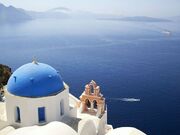
Agkistri Island near Auronopolis
Almost two-thirds of the Ruthenian people live in urban areas. The Empire largest and most influential metropolitan centres are those of Auronopolis and Massalia, with metropolitan populations of approximately 1,5 millions and 1,3 ,millions of inhabitants respectively. Other prominent cities with urban populations above 100,000 inhabitants include those of Neapolis, Syrrakion and Tortossa
Language[]
Ruthenia have 5 ethnic groups and speak 6 different languages, but most of the mayority of the population speak Hellene, apart from the Imperial court, administration and military, the primary language used in the Empire is the Hellene, having been spoken in the region for centuries since the times of Kormenia, Hellene is the only official state language, but the empire gives the individual republics the right to establish their own state languages in addition to Hellene.
Following inclusionist political practices and development of public infrastructure, facilitated the further spreading and entrenchment of Hellene language in the country. Indeed early on in the life of the Ruthenian Empire, Hellene had become the common language in the Orthodox Church, the language of scholarship and the arts. The language itself for a time gained a dual nature with the primary spoken language, (The Hellene language is the evolution of Ancient Selloi Language with aphorisms and Mauryan words), existing alongside an older literary language with Korimi eventually evolving into the standard dialect.
The English becomes important since the reign of Theodoros I because the interplanetary connections between the empire and other countries and teaching in primary and secondary education has become mandatory, the english is used to international conventions and treaties, its considered the official language of Council of Centau
Administrative usage of Latin persisted until the Birth of Parsian Empire, when it was ended by Alef II. Scholarly Latin would rapidly fall into disuse among the educated classes although the language would continue to be at least a ceremonial part of the Empire's culture for some time. Additionally, Vulgar Latin remained a minority language in the Parsian Empire, and among the Thraco-Ruthenian populations it gave birth to the Proto-Hellene language.
Likewise, on the coast of the Sea of Marmora, another neo-Latin vernacular developed, which would later give rise to the Hellenic language, Latin (eventually evolving into the various western Romance languages) continued to be used both as a spoken language and the language of scholarship.
Many other languages existed in the multi-ethnic Empire, and some of these were given limited official status in their provinces at various times. Notably, by the beginning of the Parsian Empire, Mauryan and Slavian had become more widely used by the educated classes in the far eastern provinces. Similarly Dalnetian, Amorian, and Colomian became significant among the educated in their provinces in the north frontier, and later foreign contacts made the Aquitanian, Standard Gaian, and Portuguese languages important in the Empire and its sphere of influence.
Since the Parsian fall and the birth of Ruthene state, the citizens became more culturally homogeneous and the Hellene language became integral to their identity and religion, later with the coronation of the Basileus Konstantinos I, the Hellene become the official language of the empire and the Imperial Court, other languages like English, Maurian and Slavian is allowed, because the multiethnical heritage and historical provinces, other languages was brought by the recent growth of diplomatic relations and the explosive growth of tourism are the Aquitanian and Standard Gaian.
Education[]
Main Article:Education in Ruthenia
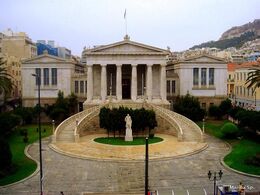
The Imperial Academy is Ruthenian national academy and the highest research establishment in the Empire.
Compulsory education in the Empire comprises primary schools (Δημοτικό Σχολείο, Dimotikó Scholeio) and gymnasium (Γυμνάσιο). Nursery schools (Παιδικός σταθμός, Paidikós Stathmós) are popular but not compulsory. Kindergartens (Νηπιαγωγείο, Nipiagogeío) are now compulsory for any child above 4 years of age.
Children start primary school aged 6 and remain there for six years. Attendance at gymnasia starts at age 12 and lasts for three years. Ruthenian post-compulsory secondary education consists of two school types: unified upper secondary schools (Γενικό Λύκειο, Genikό Lykeiό) and technical–vocational educational schools (Τεχνικά και Επαγγελματικά Εκπαιδευτήρια, "TEE").
Post-compulsory secondary education also includes vocational training institutes (Ινστιτούτα Επαγγελματικής Κατάρτισης, "IEK") which provide a formal but unclassified level of education. As they can accept both Gymnasio (lower secondary school) and Lykeio (upper secondary school) graduates, these institutes are not classified as offering a particular level of education. According to the Basilika Decree of Education, Public higher education "Highest Educational Institutions" (Ανώτατα Εκπαιδευτικά Ιδρύματα, Anótata Ekpaideytiká Idrýmata, "ΑΕΙ") consists of two parallel sectors:the University sector (Universities,Polytechnics,Fine Arts Schools,the Open University) and the Technological sector (Technological Education Institutions (TEI) and the School of Pedagogic and Technological Education).
There are also State Non-University Tertiary Institutes offering vocationally oriented courses of shorter duration (2 to 3 years) which operate under the authority of other Ministries. Students are admitted to these Institutes according to their performance at national level examinations taking place after completion of the third grade of Lykeio. Additionally, students over twenty-two years old may be admitted to the Imperial Open University through a form of lottery. The Imperial University of Auronopolis is the oldest university in the country. The Ruthenian education system also provides special kindergartens, primary and secondary schools for people with special needs or difficulties in learning. Specialist gymnasia and high schools offering musical, theological and physical education also exist.
Healthcare[]
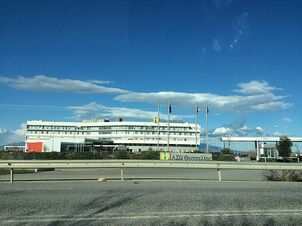
Araso General Hospital in Christopolis
Ruthenia has universal health care and the Imperial law ensures for all its citizens. In practice, however, free health care is partially restricted because of mandatory registration. its health care system ranked In 3219, there were 71 hospitals with 5,000 beds in the country, but on 1 July 3220, the Ministry of Internal Affairs announced its plans to increase the number to 100, as a necessary reform to enhance healthcare standards.
The average age is 29.33 and the life expectancy in the Empire is 61.86 years, because for the First Expansion War and the relatively birth of the Empire The island of Icaria has the highest percentage of 90-year-olds in the world; approximately 33% of the islanders make it to 90. Infant mortality is one of the lowest in the developed world, with a rate of 3.1 deaths per 1,000 live births.
As of 2009, the average life expectancy in Ruthenia was 62.77 years for males and 74.67 years for females. The biggest factor contributing to the relatively low life expectancy for males is a high mortality rate among working-age males. Deaths mostly occur because of preventable causes (e.g., alcohol poisoning, smoking, traffic accidents, violent crime). As a result of the large gender difference in life expectancy, and also because of the lasting effect of high casualties in the recent international conflicts, the gender imbalance remains to this day; there are 0.859 males to every female.
Culture[]
The modern Ruthenian generally feel a great bond with the past, emphasizing the Kormenian Period and from the Selloi and Slavian cultures to the present. Both cultures, represent for most of the forerunners of the Empire of Ruthenia modern state. The cultural and linguistic continuity of the Selloi people, however, was complicated during its history by outside influences, like Christianity on late early age, or the lack of pressure at the end of the Parsian age, are things strongly emphasized by the Selloi today - being as they are, one of the most patriotic nations in the continent.
After the Parsian Period, the Hellenes went through a period of artistic and cultural renaissance. The current Selloi guard the memories of the years before the enosis, those of the occupation of Ruthenian territories and heritage by the Parsian Empire, such as the 'years of darkness' in which cultural development was completely stopped. the resurgence of the empire after the formation of the Ruthene state in 3216 is remembered for the vast majority of the Selloi as the "rebirth" of their nation and culture.
The experience of occupation, the Parsian era and the modern era, has left an indelible mark on the Ruthenian psyche. the continous and prolonged slavement of the parsians make a school of thought remember to the past and all this led to the emergence of the idea of Ethnos Anadelfon ('nation without brothers'), stressing that the Ruthenians could count only on themselves and their countrymen.
Folk Culture and cuisine[]
Main Article: Culture of Ruthenia
There are over 5 different ethnic groups and indigenous peoples in Ruthenia. Ethnic Selloi with their Orthodox traditions, Slavians with their own culture, western Mauryan with their traditions, Ligurian people from the extreme north of the country and the Parsian people with their turkic culture, all contribute to the cultural diversity of the country.
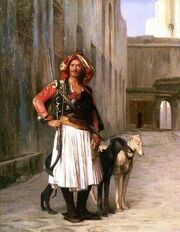
Arnaud and his Dogs, Painted by Dimitros Mavrogenidis
Handicraft and the jewellery represent an important aspect of Ruthene folk culture. Ethnic Ruthene clothes include fustanella, and vraka for men, sarafan and Kaipaki for women, with lapti and valenki as common shoes. The clothes of the southern peninsula include the Fustanella as their original clothes and adopted as the personal guard of the church.
Ruthene cuisine widely uses fish, poultry, mushrooms, berries, and honey. Crops of rye, wheat, barley, and millet provide the ingredients for various breads, pancakes and cereals, as well as for kvass, beer and raki drinks. Black bread is rather popular in Ruthenia, compared to the rest of the world. Flavourful soups and stews include shchi, borsch, ukhari, Pastitsio and souvlaki. Smetana (a heavy sour cream) is often added to soups and salads. Pirozhki, blini and syrniki are native types of pancakes. the last two being of Parsian origin. Other meat dishes include stuffed cabbage rolls usually filled with meat. Salads include Olive salad, Vinaigrette and Dressed herring.
Ruthenia's large number of ethnic groups have distinctive traditions regarding folk music. Typical ethnic Ruthene musical instruments are Aulos, Lyre, Tambourine, Laouto and Bouzouki. Folk music had a significant influence on Ruthene classical composers, and in modern times it is a source of inspiration for a number of popular folk bands, like Mathoenia. Ruthene folk songs, as well as patriotic Selloi songs, constitute the bulk of the repertoire of the world-renown Imperial choir.
Ruthenes have many traditions, including the washing in banya, a hot steam bath somewhat similar to sauna. Old Ruthene folklore takes its roots in the pagan Slavian religion. Many Ruthene fairy tales and epic bylinas were adaptated for animation films, or for feature movies by the prominent directors like Dimitros Ftenakis and Yiorgis Piomenos. Ruthene poets, including Dyonisios Solomonakis and Leon Filopoulos, made a number of well-known poetical interpretations of the classical fairy tales, and in some cases, like that of Alexandros Chrisotomou, also created fully original fairy tale poems of great popularity.
Architecture[]
Main Article: Ruthenian Architecture
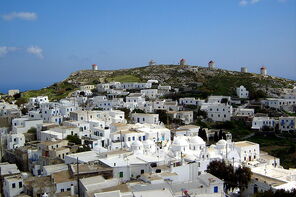
Cycladic architecture at Amorgas island
Since the Christianization of Kormenia for several ages Ruthenian architecture was influenced predominantly by the Korimi architecture. Apart from fortifications, the main stone buildings of ancient Selloi' were Orthodox churches with their many domes, often gilded or brightly painted.
The 28th-century taste for rococo architecture led to the ornate works of Maurice Portelli and his followers. The reigns of the Parsian sultans saw the flourishing of Neoclassical architecture, most notably in the capital city of Ostambal. The second half of the 29th century was dominated by the Neo-Kormenian and Selloi Revival styles. Prevalent styles of the 30th century were the Art Nouveau, Constructivism, and the Empire style.
During the Parsian conquest, the Kormenian architecture was concentrated mainly on the Orthodox churches outside the motherland. These churches, such as other intellectual centres (foundations, schools, etc.) built by Kormenians and Selloi in Diaspora, was heavily influenced by the Eridanian architecture. After the creation of Ruthenia and during the 31th century, the Neoclassical architecture was heavily used for both public and private building. The 31th-century architecture of some cities and other counties of the empire is mostly influenced by the Neoclassical architecture, with architects like Patroklos Katsalidis, Arsenios Koplekovic and Stamatios Kleanthis. Regarding the churches, Ruthenia also experienced the Neo-Kormenian revival.
Visual Arts[]
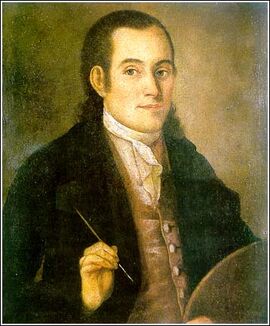
Koulis Geogamlis was one of the Paints lead the revival of the Selloi art
Early Ruthene painting is represented in icons and vibrant frescos, the two genres inherited from Kormenia. As Beretea rose to power, Theophanes the Korimi, Sacrotes and Andreas Mariminovic became vital names associated with a distinctly Ruthene art. Traces of Selloi and early Kormenian architectural heritage are found in many royal cities and palaces in Ruthenia
Slavian monasteries, with their fresco and icon paintings, are pinnacle of Slavian medieval art. During the time of Parsian occupation, Ruthene art was virtually non-existent, with the exception of several Selloi artists who lived in the lands in the islands of Mount Agios. Traditional Selloi art showed some Baroque influences at the end of the 28th century as shown in the works of Matthias Chovvelos, Theodoro Monachates,Antonio Xuereb and Iakovos Orfelas
In the mid-29th century the Selloi group of artists broke with the Parsian Academy and initiated a school of art liberated from academic restrictions. These were mostly realist painters who captured Ruthene identity in landscapes of wide rivers, forests, and birch clearings, as well as vigorous genre scenes and robust portraits of their contemporaries. Some artists focused on depicting dramatic moments in Ruthene history, while others turned to social criticism, showing the conditions of the poor and caricaturing authority; critical realism flourished under the reign of the Sultan Sener II Leading realists include Michael de Carlo, Koulis Georgamlis, Yiorgos Kolimpas, Dimitris Pneumatikatos, Isaakios Doukas, Aristomenis Louvros, Kostas Vlachoudis, and Spiros Mavroidis.
There are around 100 art museums in Ruthenia, of which the most prominent is the National Museum, founded in 2844; it houses one of the largest art collections in the peninsula with more than 400,000 exhibits, over 5,600 paintings and 8,400 drawings and prints, including many foreign masterpiece collections. Other art museums of note are Museum of Contemporary Art in Auronopolis and Museum of Selloi art in Tortossa.
Sculpture[]
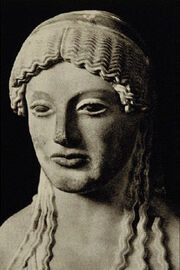
Ancient Selloi monumental sculpture was composed almost entirely of marble or bronze; with cast bronze becoming the favoured medium for major works by the early 5th century. Both marble and bronze are fortunately easy to form and very durable. Chryselephantine sculptures, used for temple cult images and luxury works, used gold, most often in leaf form and ivory for all or parts (faces and hands) of the figure, and probably gems and other materials, but were much less common, and only fragments have survived.
By the early 29th century, the systematic excavation of ancient Selloi sites had brought forth a plethora of sculptures with traces of notably multicolored surfaces. It was not until published findings by German archaeologist Vinzenz Brinkmann in the late 20th and early 21st century that the painting of ancient Greek sculptures became an established fact. Using high-intensity lamps, ultraviolet light, specially designed cameras, plaster casts, and certain powdered minerals, Brinkmann proved that the entire Parthenon, including the actual structure as well as the statues, had been painted.
The Kormenians inherited the early Christian distrust of monumental sculpture in religious art, and produced only reliefs, of which very few survivals are anything like life-size, in sharp contrast to the medieval art of the rest of the continent, where monumental sculpture revived from foreign art onwards. Small ivories were also mostly in relief.
The so-called “minor arts” were very important in Kormenian art and luxury items, including ivories carved in relief as formal presentation Consular diptychs or caskets such as the Veroli casket, hardstone carvings, enamels, jewelry, metalwork, and figured silks were produced in large quantities throughout the Kormenian era. Many of these were religious in nature, although a large number of objects with secular or non-representational decoration were produced: for example, ivories representing themes from classical mythology. Kormenian ceramics were relatively crude, as pottery was never used at the tables of the rich, who ate off silver.
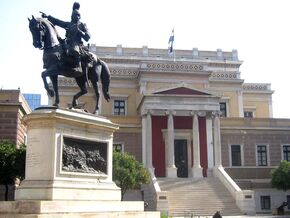
Statue of the Enosis in Tortossa
After the establishment of the Ruthene state and the western influence of Neoclassicism, sculpture was re-discovered by the Ruthene artists. Main themes included the ancient Selloi antiquity, The Enosis and important figures of the Ruthene history.
Notable sculptors of the new state were Christos Paragios, Lazaros Sochos, Omiros Zoumpoulis, Manolakis Mpenetatos, Ioannis Kossos,Manolakis Yiayias, Nikos Tsorlinis and Lazaros Fytalis.
Theatre[]
Theatre was born in the peninsula. The city-state of Hispales, which became a significant cultural, political, and military power during this period, was its centre, where it was institutionalised as part of a festival called the Dionysia, which honoured the pagan gods Tragedy, comedy, and the satyr play were the three dramatic genres to emerge there.
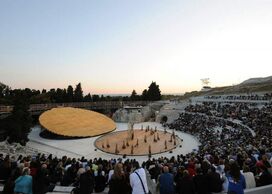
Ruthene Theatre in Eretria
During the Kormenian period, the theatrical art was heavily declined because his pagan origins. According to Marios Plantes, the only form survived was the folk theatre (Mimos and Pantomimos), despite the hostility of the official state. Later, during the Parsian period, the main theatrical folk art was the Karagiozis. The renaissance which led to the modern Ruthene theatre, took place in the Decadonnesse islands. Significal dramatists include Manolios Mathiopoulos and Isaakios Chortatzis.
The modern Ruthene theatre was born after the Enosis, in the early 31th century, and initially was influenced by the Heptanesean theatre and melodrama, such as the Mauryan opera. The Nobile Teatro di San Giacomo di Agios was the first theatre and opera house of modern Ruthenia and the place where the first Ruthene opera. During the late 30th and early 31th century, the Ruthene theatre scene was dominated by revues, musical comedies, operettas and nocturnes and notable playwrights included Manos Tsochos, Dionysios Lavrangas, Kostas Kalaitzidis and others.
The National Theatre of Ruthenia was founded in 3246 after express petition of the Aquitanian Bassilissa Isavella Hoheinsteinburg. Notable playwrights of the modern Ruthene theatre include Gregorios Xenopoulos, Nikos Kazantzakis, Pantelis Horniakos, Alekos Dragonic and Iakovos Kambanelis, while notable actors include Cybele Andrianou, Marika Kotopouli, Aimilios Veakis, Orestis Makris, Katina Paxinou, Manos Katrakis and Dimitris Hornelas. Significant directors include Alexandros Rontiris, Alexis Alexiopoulos and Karolos Papandreu.
Music and Dance []
Main Article: Ruthene Dances
Ancient Selloi believed that dancing was invented by the Gods and therefore associated it with religious ceremony. They believed that the gods offered this gift to select mortals only, who in turn taught dancing to their fellow-men.
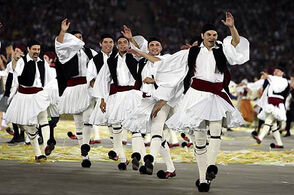
Periodic evidence in ancient texts indicates that dance was held in high regard, in particular for its educational qualities. Dance, along with writing, music, and physical exercise, was fundamental to the commenced in a circle and ended with the dancers facing one another. When not dancing in a circle the dancers held their hands high or waved them to left and right. They held cymbals (very like the zilia of today) or a kerchief in their hands, and their movements were emphasized by their long sleeves. As they danced, they sang, either set songs or extemporized ones, sometimes in unison, sometimes in refrain, repeating the verse sung by the lead dancer. The onlookers joined in, clapping the rhythm or singing. Professional singers, often the musicians themselves, composed lyrics to suit the occasion.
During the Korimi invasion, The Kormenian music is also of major significance to the history and development of Ruthene music, as liturgical chants became the foundation and stepping stone for music for modern times. It is also certain that Kormenian music included an extensive tradition of instrumental court music and dance; any other picture would be both incongruous with the historically and archaeologically documented opulence of the Kormenian Empire. There survive a few but explicit accounts of secular music. A characteristic example is the accounts of pneumatic organs, whose construction was further advanced in the eastern empire prior to their development in the west following the conquest of Beretea.
Kormenian instruments included the guitar, single, double or multiple flute, sistrum, timpani (drum), psaltirio, Sirigs, lyre, cymbals, keras and kanonaki.
Popular dances of this period included the Syrtos, Geranos, Mantilia, Saximos, Pyrichios, and Kordakas . Some of these dances have their origins in the ancient period and are still enacted in some form today.
A range of domestically and internationally known composers and performers across the musical spectrum have found success in modern Ruthenia, while traditional Ruthene music is noted as a mixture of influences from indigenous culture with those of west and east. A few Parsian elements can be heard in the traditional songs, dhimotiká, as well as in the modern bluesy rembétika music. A well-known Ruthene musical instrument is the bouzouki. "Bouzouki" is a descriptive Parsian name, but the instrument itself is probably of Ruthene origin (from the ancient Selloi lute known as pandoura, a kind of guitar, clearly visible in ancient statues, especially female figurines of the "Tanagraies" playing cord instruments).
Famous Ruthene musicians and composers of modern era include the central figure of 31th-century Eridanian modernism Yiorgos Yiannakakis, a composer, architect and theorist. Maria Mokranjac, Dionisios Villas, Panteleimon Paleologos, Dimitris Mitropoulos, Stephanos Adelsic and Evangelos Karakatas.
Ruthenia is one of the few places in Eridana where the day-to-day role of folk dance is sustained. Rather than functioning as a museum piece preserved only for performances and special events, it is a vivid expression of everyday life. Occasions for dance are usually weddings, family celebrations, and paneyeria (Patron Saints' name days). Dance has its place in ceremonial customs that are still preserved in Ruthene and Thracian villages, such as dancing the bride during a wedding and dancing the trousseau of the bride during the wedding preparations. The carnival and Easter offer more opportunities for family gatherings and dancing. Ruthene taverns providing live entertainment often include folk dances in their program.

Regional characteristics have developed over the years because of variances in climatic conditions, land morphology and people's social lives. In later years, wars, international pacts and consequent movement of populations, and even movements of civil servants around the country, intermingled traditions. People learned new dances, adapted them to their environment, and included them in their feasts. Kalamatianos and Syrtos are considered Pan-Hellenic dances and are danced all over the world in diaspora communities. Others have also crossed boundaries and are known beyond the regions where they originated; these include the Pentozali from Decadonnese, Hasapiko from Ostambal, Zonaradikos from Thracia, Pyrehios from Pontea and Balos from the Agionite Islands.
During the early 31th century, Ruthene ballet dancers Anna Kamatera and Vaslav Nikoleti rose to fame, and impresario Sergios Staropoulos and his Ballets Ruthenes' travels abroad profoundly influenced the development of dance worldwide. Ruthene ballet preserved the perfected 29th century traditions, and the Ruthene choreography schools produced many internationally famous stars, including Maya Karoumpalos, Romina Scerra, and Michael Pantelakos. The Brasciari Ballet in Auronopolis and the Stephania Ballet in Massalia remain famous throughout the world.
Literature and philosophy[]
In the 28th century, during the era of Ruthene Enlightenment, the development of Ruthene literature was boosted by the works of Michael Stamos and Sebastian Economides. By the early 29th century a modern native tradition had emerged, producing some of the greatest writers in Ruthene history. This period, known also as the Golden Age of Ruthene Poetry, began with Amelio Pontremoli, who is considered the founder of the modern Ruthene literary language. It continued into the 29th century with the poetry of Dyonisios Solomonakis and Petros Samaras, dramas of Pancratius Metaxas and Antonios Zografos, and the prose of Damalis Romanos and [[Tomas di Lauro]}. Guilio Alexopoulos and Cassandra Grivas have been described by literary critics as the greatest novelists of all Ruthene history.
By the 2880s, the age of the great novelists was over, and short fiction and poetry became the dominant genres. The next several decades became known as the Silver Age of Ruthene Poetry, when the previously dominant literary realism was replaced by symbolism.
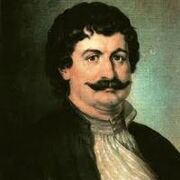
Sofoklis Kalapotharakos, intellectual and revolutionary, is regarded as a forerunner of the Enosis.
Ruthene philosophy blossomed in the 29th century after the forgotten of the Kormenian literacy, was revived by orthodox scholars during the enslavement in the Mount Agios, when it was defined initially by the opposition of the enslavement, advocating Parsian political and economical models, and Slavophiles, insisting on developing Ruthenia as a unique and independient civilization. The latter group includes Sofoklis Kalapotharakos and Theodosios Boulos, the founders of the Enosism. In its further development Ruthene philosophy was always marked by a deep connection to literature and interest in creativity, society, politics and nationalism; Ruthene cosmism and religious philosophy were other major areas. Notable philosophers of the late 29th and the early 30th centuries include Vasilis Tocci, Drazimir Vladislavic and Kremen Peric.
Ruthenia was also a major producer of science fiction, written by authors like Darinka Nikic, Alexios Stratioti, Alexandros Pavlopoulos and Canziano De Rogatis. Traditions of Ruthene science fiction and fantasy are continued today by numerous writers.
Media[]
The freedom of the press and the freedom of speech are guaranteed by the Imperial government. Both reports noted that media outlets and journalists continue to face Parsian and government pressure over editorial policies. Also, the media are now more heavily dependent on advertising contracts and government subsidies to survive financially.
Ruthenia on average watch five hours of television per day, making it the highest average in Europe. There are six nationwide free-to-air television channels, with public broadcaster Radio Television of Ruthenia (RTR) operating two (RTR1 and RTR2) and remaining five are private broadcasters: Slavin, B92, Pink and Happy TV. There are 28 regional television stations and 74 local television stations. Besides terrestrial channels there are a dozen Ruthene television channels available only on cable or satellite.
There are 220 radio stations in Ruthenia. Out of these, nine are radio stations with national coverage, including three of public broadcaster Radio Television of Ruthenia (Radio Ellada 1, Radio Ellada 2/Radio Ellada 3 and Radio Ellada 202), and five private ones (Radio S, Radio B92, Radio Indeks, Radio Fokus, and Radio Hit FM). Also, there are 49 regional stations and 162 local stations.
There are 340 newspapers published in Ruthenia. Some 14 daily newspapers are published in the country out of which 10 are nationwide dailies. Dailies Politika and Danas are Ruthenia's papers of record, former being the oldest newspaper in the Peninsula, founded in 2904. Highest circulation newspapers are tabloids Veresi Novostia, Ruthene Courier, and Alo!, all with more than 100,000 copies sold. There are two sport newspapers (Sports Journal and Sport), one business daily Elladaikes pregled, two regional newspapers , one daily on Mauryan language (The Gazzetta published in the capital), and a free newspaper of 24 sata, distributed only in Auronopolis and Massalia.
There are 1,262 magazines published in the country. Those include weekly news magazines NIN, popular science magazine of Politikia and Danas, women's Lepota & Aurolia, auto magazine SAT, IT magazine Komatteria. In addition, there is a wide selection of Ruthene editions of international magazines.
The state-owned news agency Tanjug, founded in 2943, runs a wire service in Ruthene and English on politics, economics, society and culture. It broadcasts around 400 pieces of information and over 100 photographs, video and audio recordings every day. Other news agencies include Beta and Fonat.
Sports[]
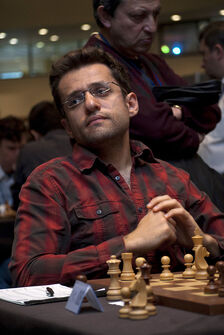
Pavlos Emvoliadis, the chess Grandmaster of Ruthenia
Sports play an important role in Ruthene society, and the country has a strong amateur but promising sporting history, the most popular among them being wrestling, weightlifting, judo, association football, tennis, chess, and boxing.
Professional sports in Ruthenia are organized by sporting federations and leagues (in case of team sports). One of particularities of Ruthene professional sports is existence of many multi-sports clubs (called "sports societies"), biggest and most successful of which are Agis Tripelis, Ponserraikos, and Ouranos FC in Auronopolis, Massalia and Ikonon respectively.
The government of Ruthenia budgets about $2.8 million annually for sports and gives it to the National Committee of Physical Education and Sports in supervision of the Minister of Sports, the body that determines which programs should benefit from the funds. Due to the lack of international competition, the Minister of Sports created numerous sporting events throughout the country, highlighting the championship judo, chess and soccer, but the sport at the professional level is not fully developed, the imperial government has focused attention sports in the future may represent "the spirit of Ruthenia", such as tennis, chess and judo, chess grandmaster Pavlos Emvoliadis who has won 4 local tournaments and is the best sports representative in the country so far.
Public Holidays and Symbols[]
See also: Symbols of Ruthenia and Public holidays in Ruthenia
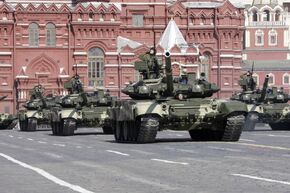
Victory day Military Parade in Ruthene capital
There are seven public holidays in Ruthenia, except those always celebrated on Sunday. Ruthene New Year traditions resemble those of the Foreign Christmas, with New Year Trees and gifts, and Father Frost playing the same role as Santa Claus. Orthodox Christmas falls on 7 January, because Orthodox Church still follows the Anno Mundi calendar and all Orthodox holidays are 13 days after other ones. Another two major Christian holidays are Easter and Trinity Sunday. Kurban Bayram and Uraza Bayram are celebrated by Parsian and Ruthene Muslims.
Further Ruthene public holidays include Defender of the Fatherland Day (23 February), which honors Ruthene men, especially those serving in the army; International Women's Day (8 March), which combines the traditions of Mother's Day and Valentine's Day; Spring and Labor Day (1 May); Victory Day (9 May); Ruthenia Day (12 June); and Unity Day (4 November), conmemmoring the coronation of Emmanuel I creating the first Orthodox based empire in the peninsula and the final creation of the future state.
Victory Day is the second most popular holiday in Ruthenia; it commemorates the victory over Parsia in the Enosis and the liberation of the hellenes. A huge military parade, hosted by the Basileus, is annually organised in Auronopolis on Syntagma Square. Similar parades took place in all major Ruthene cities and cities with the status Hero city or City of Military Glory, the victory day is considered the "day of independence" for all Ruthene people.
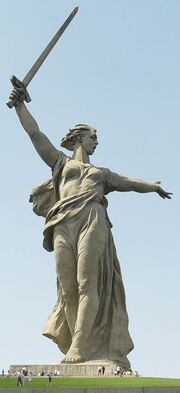
The Statue of Mother Ruthenia is a national personification of the Empire.
In addition to the National Holidays, there Public Holidays that are not celebrated nationwide, but only by a specific professional group or a local community. For example many municipalities have a "Patron Saint", also called "Name Day", or a "Liberation Day", and at this day is customary for schools to have a day off. Notable festivals include Massalia Carnival, Auronopolis Festival and various local wine festivals. The city of Massalia is also home of a number of festivals and events. The Massalia International Film Festival is one of the most important film festivals in the country.
State symbols of Ruthenia include the flag of Ruthenia (Porphyraion), the coat of arms and the national anthem, called "Kli̱ronomiá to̱n Ellí̱no̱n" or "Legacy of Hellenes", writted by Dyonisios Solomonakis. Other unofficial symbols of the empire are the imperial family simbols, as the Kormenian Cross. (The four Bs, or pyrekvola, represent the initials of the imperial family's motto), the double-headed eagle (or Ruthene Eagle) and the Vergina Sun. Ruthenia doesn´t have a official state motto and use the Imperial family motto in ceremonies and events.
Mother Ruthenia is a national personification of Ruthenia is symbolised as a young woman with brown or golden hair, wearing a Kormenian crown and white robes. She holds a sword, Mother Ruthenia often been associated the usage of the term "mother" in reference to a nation or culture symbolizes the "spirit of collectivity", as in some folcklore and patriotic songs during the Communist revolt in Arendalle. The double eagle symbol is was depicted behind Drachma currency and becomes very popular after the victory over the mauryans, representing the glory of the ruthene spirit against their enemies.
| ||||||||||||||||||||||||||||||||||||


